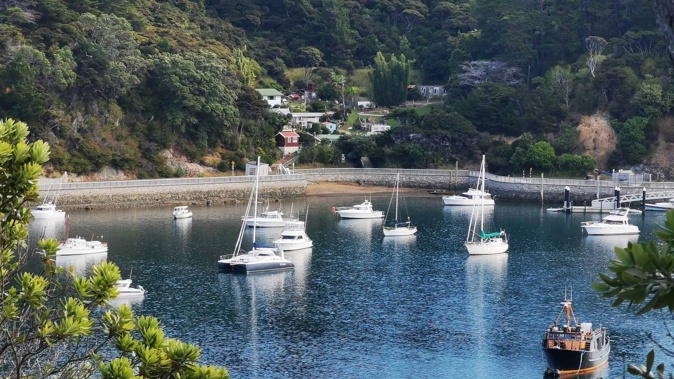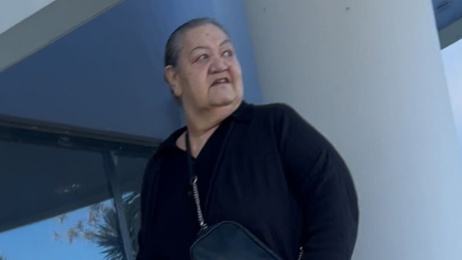
There are calls to make one of Auckland’s favourite getaway spots off-limits to boaties this summer, amid what threatens to be an environmental disaster for New Zealand.
To stop exotic caulerpa seaweed from invading the rest of the Hauraki Gulf, there’s now discussion over whether a total anchoring ban is needed at worst-hit Aotea/Great Barrier Island.
The foreign pest’s big threat doesn’t just come with its swift rate of spread – it’s capable of growing by as much as three centimetres a day in warm, clear waters like those of the gulf – but the smothering effect its vast, dense mats has on the marine environment.
In the Mediterranean, it took only six years to drive a 50 per cent drop in fish biomass and a 30 per cent fall in biodiversity – and there were fears of similar impacts in the gulf, where the green menace has spread across hundreds of hectares since its detection at Aotea’s Blind Bay in mid-2021.
Along with several sites at Aotea, it’s now been confirmed at Great Mercury Island, Waiheke Island, at Iris Shoal northwest of Kawau Island, and at Rāwhiti Inlet in the Bay of Islands.
/cloudfront-ap-southeast-2.images.arcpublishing.com/nzme/G67TXOF2MJGKRPOZMCB53AKXZU.jpg) Aotea/Great Barrier Island's marine environment has been under threat from the highly-invasive exotic caulerpa seaweed since 2021. Here, it's pictured washed up at Okupu beach in the aftermath of February's ex-tropical cyclone Gabrielle. Photo / Noel Nancekivell
Aotea/Great Barrier Island's marine environment has been under threat from the highly-invasive exotic caulerpa seaweed since 2021. Here, it's pictured washed up at Okupu beach in the aftermath of February's ex-tropical cyclone Gabrielle. Photo / Noel Nancekivell
Massey University’s Emeritus Professor Barry Scott worried it could go on to displace ecosystems and affect species like scallops, mussels, cockles and fish that normally roam shallow inshore waters.
“This has got to be the most serious invasive species to impact on our natural environment that I have seen,” said Scott, a prominent molecular geneticist who serves as deputy chairman of the Aotea Great Barrier Environmental Trust (Agbet).
/cloudfront-ap-southeast-2.images.arcpublishing.com/nzme/O6BBAW3HSVCW3GDE2QIEMJ26AM.jpg) This map shows where exotic caulerpa seaweed has been so far detected in the Hauraki Gulf. Source / Auckland Council
This map shows where exotic caulerpa seaweed has been so far detected in the Hauraki Gulf. Source / Auckland Council
“The potential to damage the seabed of many of the harbours and bays along the northeast coast of the North Island, from Tauranga to the Far North, is quite frightening.
“Taking into account the marine areas where exotic caulerpa potentially could thrive, this incursion has the potential to be much greater than kauri dieback, myrtle rust and other invasives which have arrived here in recent years.”
He suspected the seaweed most likely came here hitched to a yacht or larger ship - and vessels still posed a huge risk for spread, with Biosecurity New Zealand (BNZ) having placed restrictions banning boaties from fishing and anchoring at the main affected Aotea sites.
/cloudfront-ap-southeast-2.images.arcpublishing.com/nzme/WSDGOQEBJ5BWPHXU7JSTFEPMS4.JPG)
As authorities moved to manage the pest long-term, BNZ deputy director-general Stuart Anderson said the agency’s first step was to review those current Controlled Area Notices (Cans) and was now speaking with affected communities.
Scott suggested wider measures were needed, given the pest had spread beyond some of the Can sites.
“With summer approaching, when thousands of boats descend on Great Barrier Island, huge pressure will go on the remaining bays within Port Fitzroy, Port Abercrombie and at Katherine Bay for anchorage sites and fishing,” he said.
“If we get the fine southwest weather that usually accompanies an El Nino summer, then the risk of further spread of caulerpa along the western coastline to the eastern bays and even out to Rakitū [Island] is very great.”
There were a range of views among islanders, he said, with some favouring a total anchorage ban, but others who are against further restrictions.
“But failing to extend the current Cans beyond the end of November puts not just the remainder of Great Barrier Island at risk, but all of the Hauraki Gulf and the east coast both south and north, where boats are likely to move to over the summer.”
Aotea/Great Barrier Local Board chairwoman Izzy Fordham said the incursion’s local economic impact hadn’t yet been quantified – nor had the potential impact of an island-wide anchorage ban.
“We don’t know the economic value of our boaties, except to say that, anecdotally, it’s bigger than we think.”
/cloudfront-ap-southeast-2.images.arcpublishing.com/nzme/G7Y7IFYOAREB5JMVVH7IERDVQ4.jpg) Caulerpa at Omākiwi Cove in the Bay of Islands. Photo / Northland Regional Council
Caulerpa at Omākiwi Cove in the Bay of Islands. Photo / Northland Regional Council
Board member and local charter boat owner Chris Ollivier said as the scale of the problem wasn’t yet clear, any action needed to include no anchoring.
“Yes, some boaties will be opposed to it out of self-interest, but closer examination of the result of not doing anything usually gets support.”
That included the potential loss of kaimoana around the island, which in turn would hit fishing and charter operations and the local service businesses supporting them.
With several BNZ and iwi-led trials ongoing, no scientific silver bullet’s yet been found to stop the scourge.
A trial at Aotea in 2021, using rock salt covered with hessian mats, initially proved successful, but couldn’t prevent caulerpa from re-establishing.
In the latest effort, divers used suction dredging to strip about 17 tonnes of caulerpa off the seabed at three sites in Tryphena Harbour, before matting and chlorine granules were also applied at some of the treated plots.
However, a recent check found some caulerpa remained, and it wasn’t clear whether the seaweed had grown back or had just not been caught by the treatment.
Anderson said the agency continued to explore options for future control in the hope of finding techniques that could stamp out small outbreaks, or knock back larger ones.
Yet the pest’s full eradication in New Zealand was “highly unlikely”, scientists had advised BNZ, given the scale of the incursion and the lack of any control tool that’d work at it.
/cloudfront-ap-southeast-2.images.arcpublishing.com/nzme/UTMMIFK6WBB2TLMT7RHFZHTZOU.jpg) This bright green invasive caulerpa seaweed is smothering the delicate marine ecosystem on Aotea/Great Barrier Island, and has spread to Te Tai Tokerau and now Tāmaki Makaurau. Photo / Glenn Edney
This bright green invasive caulerpa seaweed is smothering the delicate marine ecosystem on Aotea/Great Barrier Island, and has spread to Te Tai Tokerau and now Tāmaki Makaurau. Photo / Glenn Edney
Agbet chairwoman Kate Waterhouse said those on Aotea weren’t just anxious about the long-term situation, but “frustrated and angry” over what she called a lack of action to control the spread.
In August, island mana whenua Ngāti Rehua/Ngāti wai ki Aotea also took the dramatic step of filing a Waitangi Tribunal claim against the Crown, arguing it had failed to engage with the iwi.
“The last two years have demonstrated that Biosecurity New Zealand are simply not set up to respond in a timely or a cost-effective way to multiple sites and communities,” Waterhouse said.
Despite the growing risk, she said there still wasn’t a national management plan for caulerpa, nor had any economic and cultural impact assessments been completed.
She saw an urgent need for better planning, surveillance and co-ordination, more support for locally-led projects and greater funding, with iwi leaders from three sites suggesting $200 million be set aside.
“This is a quarter of the cost of the Mycoplasma bovis eradication programme, yet the negative impacts of caulerpa will have far greater reach into tourism, marine aquaculture, recreational and commercial fishing and coastal hapū and community wellbeing,” she said.
/cloudfront-ap-southeast-2.images.arcpublishing.com/nzme/4W6FKLSEFFDWDHQY7MP66Y4VTE.jpg) Yachts anchored at Tryphena Harbour on Great Barrier Island in April 2020. Boaties are an important contributor to the island's summer economy.
Yachts anchored at Tryphena Harbour on Great Barrier Island in April 2020. Boaties are an important contributor to the island's summer economy.
“It is beyond frustrating to communities and hapū that there has not been more support to enable locally controlled responses.
“The incoming Government has an opportunity to kick-start the process and stop the spread.”
Anderson contended Biosecurity New Zealand’s response to date had worked to slow the spread, and also to investigate tools, minimise impacts and support affected mana whenua and partners.
About $5m had been spent or committed to the response so far, a fulltime response team had been in place since the outset, and a national management plan couldn’t be finalised until various treatment trials had been completed.
The Crown had also met its Treaty and Biosecurity Act obligations, he said.
“Criticisms that the effort has been slow and inadequate do not account for the complexity of this issue,” he said.
“We are dealing with a highly invasive pest with no known effective management tools.”
Take your Radio, Podcasts and Music with you









